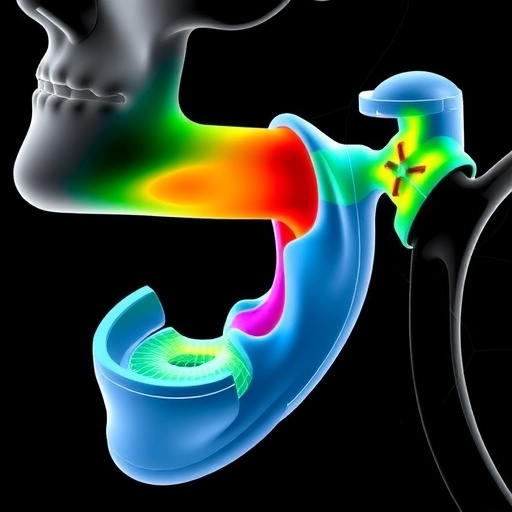In a groundbreaking study presented in the latest edition of Annals of Biomedical Engineering, researchers have taken a significant stride in understanding the dynamics of the upper airway by developing an empirical acoustic transfer function model. This innovative approach aims to bridge the gap between complex biological structures and practical engineering applications, paving the way for advanced diagnostic and treatment methodologies for respiratory conditions. The research conducted by Ashraf, Alqudah, Band, and colleagues sheds new light on how sound waves interact with the various components of the upper airway, proposing a quantifiable model to predict airflow dynamics accurately.
The upper airway plays a crucial role in breathing, acting as a conduit for air to reach the lungs while simultaneously filtering and humidifying it. However, the intricate anatomy of the airway presents challenges for understanding its acoustic properties. Traditional approaches to studying airflow dynamics often rely on simplified models that do not account for the various factors influencing airflow, including the shape, size, and structural characteristics of the airway. By constructing an empirical acoustic transfer function model, the authors aim to provide a more accurate representation of these complexities.
Central to the study is the recognition that sound waves can serve as a diagnostic tool for assessing airway function. The researchers explored the acoustic behaviors of the upper airway under various conditions by employing advanced imaging techniques and signal processing algorithms. This comprehensive approach allowed the team to capture how sound waves travel through the airway, identifying regions of resistance that may indicate potential obstructions or abnormal airflow patterns.
The implications of this research extend beyond theoretical advancements. Understanding the acoustic properties of the upper airway could revolutionize the diagnosis of sleep apnea and other respiratory disorders. By utilizing non-invasive techniques based on acoustic measurements, clinicians could assess airway function with greater accuracy, leading to earlier and more effective interventions. Additionally, this model has profound implications for the design of therapeutic devices, such as continuous positive airway pressure (CPAP) machines, which are commonly used in the management of obstructive sleep apnea.
Moreover, the empirical model developed in this study may enhance the ability to simulate and visualize airflow within the upper airway. These simulations could contribute to a better understanding of how various factors, such as vibrational frequencies and acoustic reflections, impact the overall function of the airway. This is particularly important in the context of developing tailored treatments that account for individual patient anatomy and conditions.
Acoustic transfer functions have previously found applications in diverse fields, including telecommunications and audio engineering. The innovative application of such principles to biomedical engineering represents a paradigmatic shift in how researchers approach anatomical and functional complexities. By establishing clear mathematical relationships between acoustic signals and physiological conditions, the researchers hope to unlock new techniques for monitoring and predicting airway behavior under different circumstances.
One particularly intriguing aspect of this study is its potential integration with emerging technologies, such as artificial intelligence and machine learning. As massive datasets become increasingly available in clinical settings, algorithms capable of analyzing acoustic data from the upper airway could deliver real-time insights into a patient’s respiratory health. This could lead to more personalized treatment plans and monitoring systems that automatically adjust therapeutic interventions based on acoustic feedback.
Furthermore, the researchers highlighted the need for continued investigation into the long-term impacts of acoustic interactions within the airway. While this study lays a strong foundation, there remain many unanswered questions regarding the effects of chronic conditions and environmental factors on airway acoustics. Future research could expand on this model to encompass a broader range of variables and conditions, including the influence of aging, habitual snoring, or even environmental pollutants.
The challenge of validating this empirical model through practical applications will be paramount. As researchers endeavor to transition from theoretical constructs to clinical realities, they will need to conduct rigorous testing within patient populations to refine the model further. This iterative process will help ensure that the acoustic transfer function remains clinically relevant and can fill the gaps in current diagnostic practices.
Ultimately, the innovative approach presented by Ashraf and colleagues underscores the essential interplay between engineering principles and clinical practice. The acoustic transfer function model serves not merely as an academic exercise but rather as a crucial tool that can contribute directly to improving patient care. As the field of biomedical engineering continues to evolve, studies like this one highlight the importance of interdisciplinary collaboration and the potential for transformative advancements in medical science.
In conclusion, the study conducted by Ashraf et al. marks an exciting advance in the field of upper airway research. By developing an empirical acoustic transfer function model, the authors provide invaluable insights into the acoustic properties of the airway that could lead to enhanced diagnostic capabilities and therapeutic options. As healthcare systems increasingly seek innovative solutions to combat respiratory disorders, this research may serve as a linchpin for future advancements.
This study stands as a testament to the potential of engineering applications in medicine, emphasizing the need for multidisciplinary approaches to addressing complex healthcare challenges. As researchers continue to explore the vast landscape of acoustic applications in biomedicine, our understanding of the intricate and vital functions of the upper airway will undoubtedly deepen, changing how we approach diagnosis and treatment in the realm of respiratory health.
Subject of Research: The empirical acoustic transfer function model for the upper airway.
Article Title: Developing an Empirical Acoustic Transfer Function Model for the Upper Airway.
Article References:
Ashraf, W., Alqudah, A., Band, M. et al. Developing an Empirical Acoustic Transfer Function Model for the Upper Airway. Ann Biomed Eng (2025). https://doi.org/10.1007/s10439-025-03883-z
Image Credits: AI Generated
DOI:
Keywords: Upper airway, acoustic transfer function model, respiratory disorders, diagnosis, biomedical engineering.




